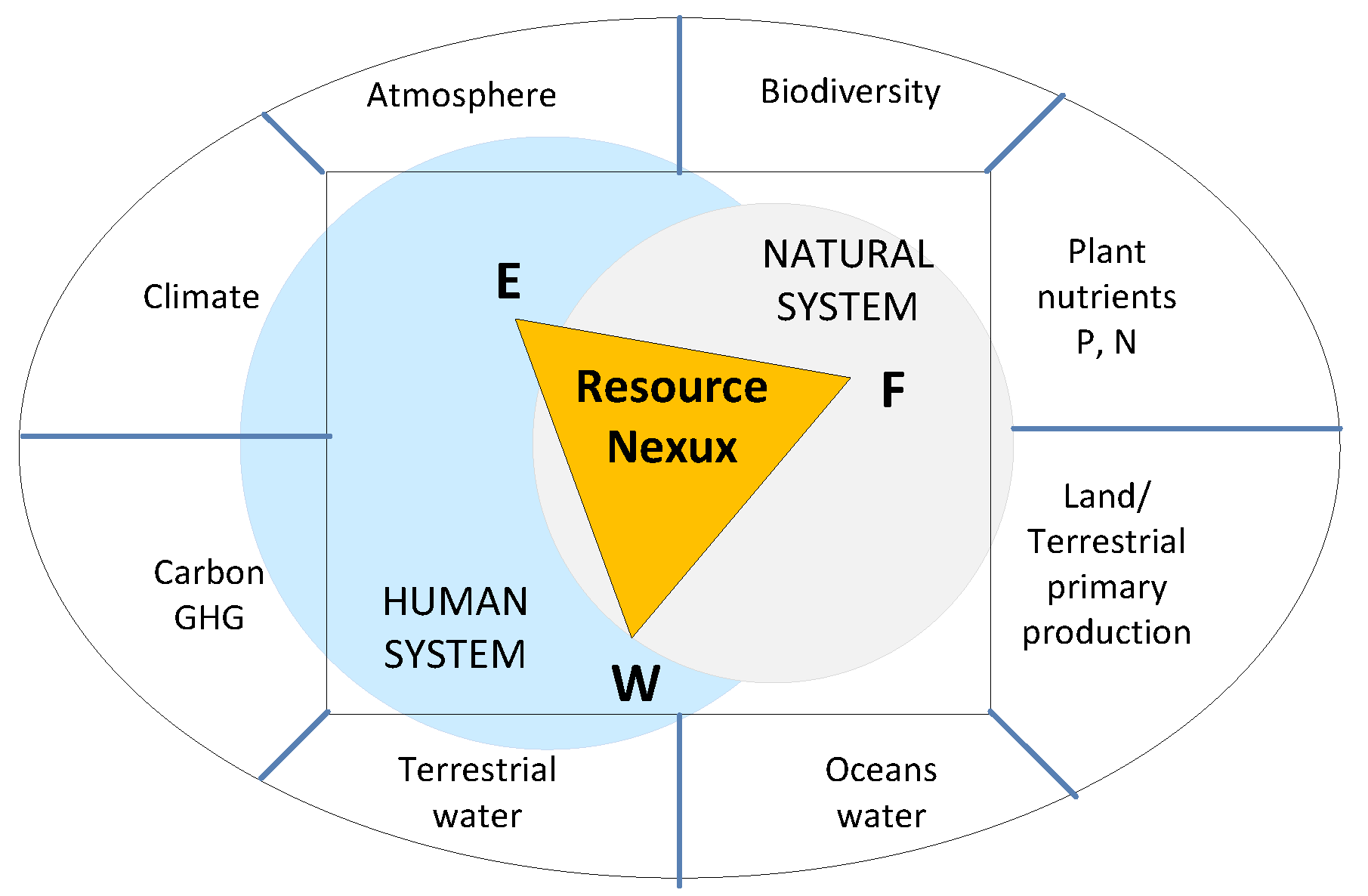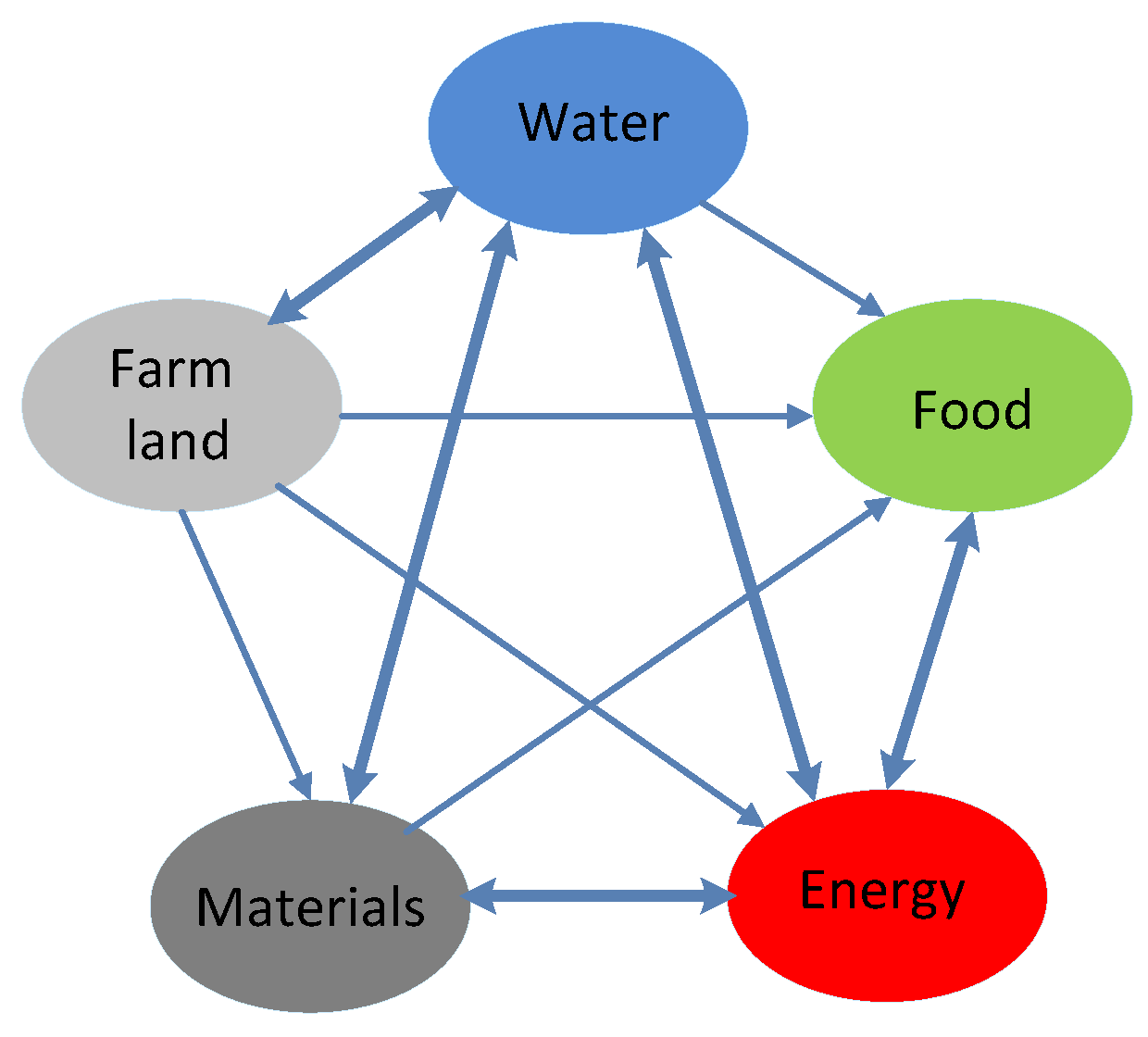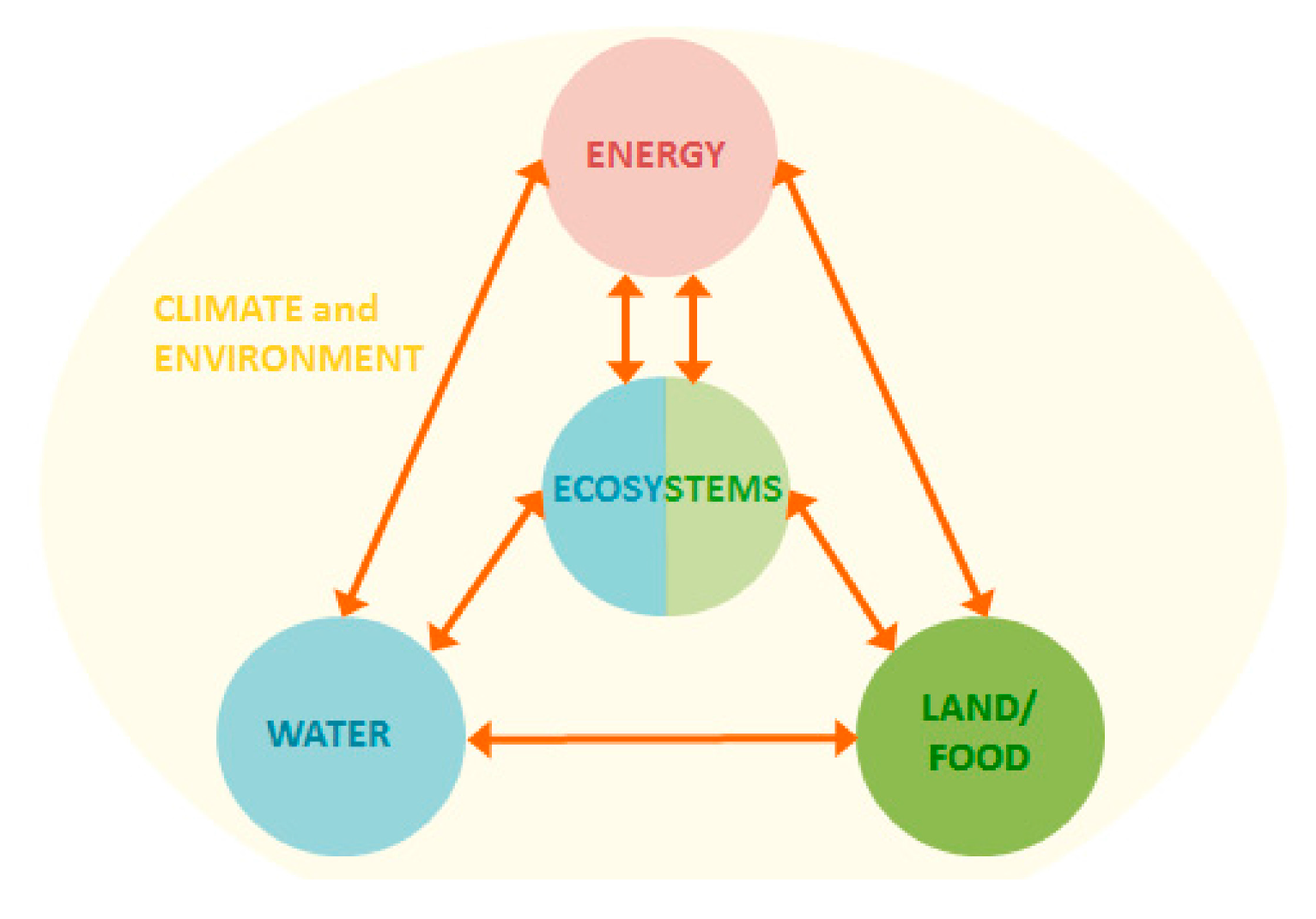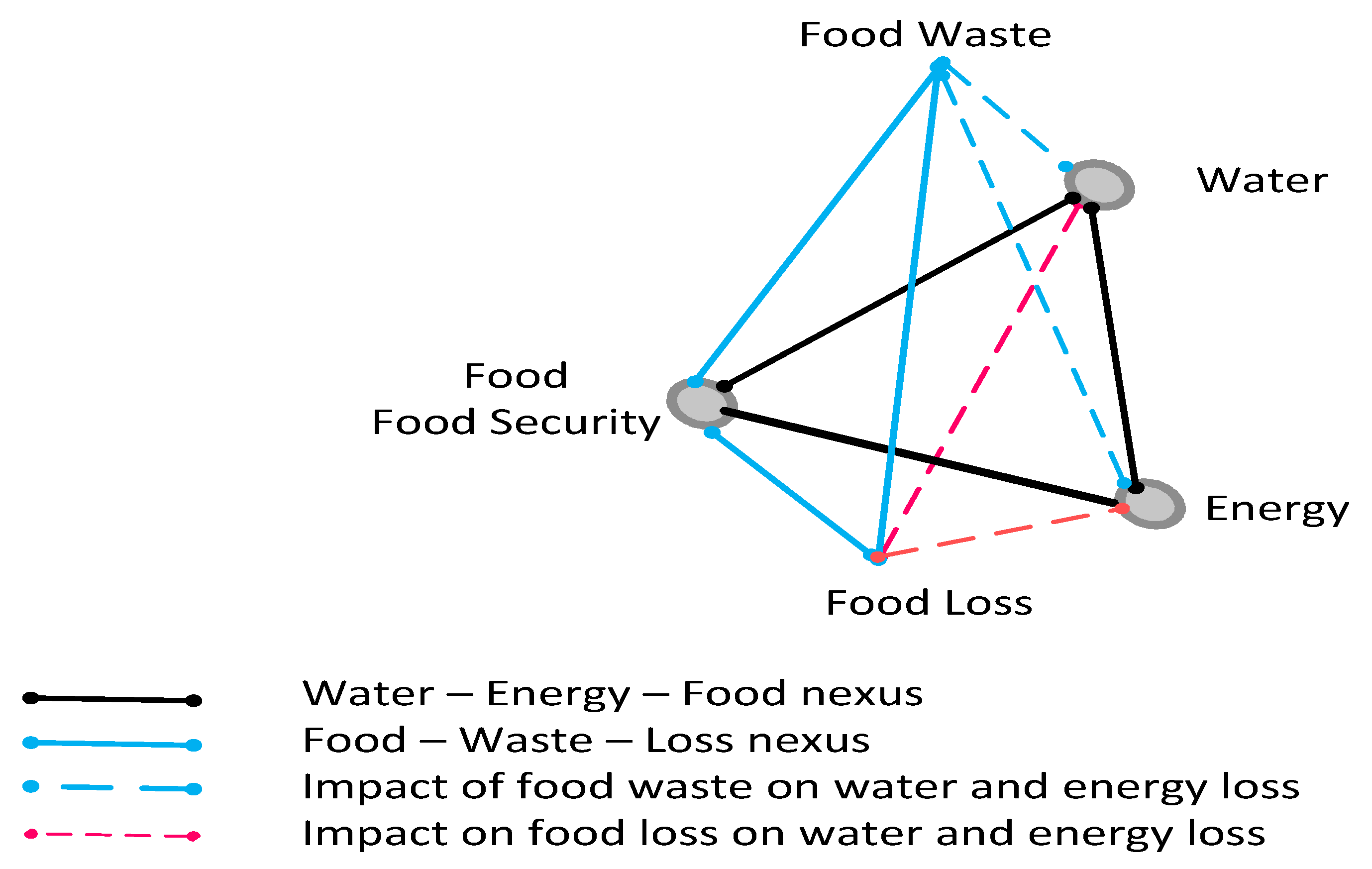Combining the Water–Energy–Food and Food Waste–Food Loss–Food Security Nexuses to Reduce Resource Waste
Abstract
:1. Introduction
2. Water–Energy–Food Nexus
W–E–F Nexus Models
3. Food Loss–Food Waste–Food Security Nexus
4. Energy and Water Use in the Food Industry
4.1. Energy
4.2. Water
5. Conclusions
Author Contributions
Funding
Institutional Review Board Statement
Informed Consent Statement
Conflicts of Interest
References
- Mekonnen, M.; Hoekstra, A. Four billion people facing severe water scarcity. Sci. Adv. 2016, 2, e1500323. [Google Scholar] [CrossRef] [PubMed]
- Hegenshold, E.; Unnikrishan, S.; Pollman-Larsen, M.; Askeldottir, B.; Gerard, M. Tackling the 1.6 Billion-Ton Food Loss and Waste Crisis. 2018. Available online: https://www.bcg.com/publications/2018/tackling-1.6-billion-ton-food-loss-and-waste-crisis.aspx (accessed on 10 August 2022).
- Rosa, W. (Ed.) Transforming Our World: The 2030 Agenda for Sustainable Development. In A New Era in Global Health; Springer Publishing Company: New York, NY, USA, 2017. [Google Scholar] [CrossRef]
- Ishangulyyev, R.; Kim, S.; Lee, S.H. Understanding Food Loss and Waste—Why Are We Losing and Wasting Food? Foods 2019, 8, 297. [Google Scholar] [CrossRef]
- Gustavsson, J.; Cederberg, C.; Sonesson, U. The Methodology of the FAO Study: “Global Food Losses and Food Waste—Extent, Causes and Prevention”-FAO, 2011. Environ. Sci. 2013, 70. [Google Scholar]
- European Commission. Preparatory Study on Food Waste Across EU 27; Technical Report—2010-054; European Commission: Brussels, Belgium, 2011. [Google Scholar]
- Zalewski, R.I.; Skawińska, E. Towards sustainable food system. Acta Sci. Pol. Oeconomia 2016, 15, 187–198. [Google Scholar]
- Global Ingredients Division. A Shift in Demand: Convenience Food & Beverage Products. Available online: https://bdingredients.com/convenience-food-and-beverage-products/ (accessed on 9 August 2022).
- Glover, D.; Sumberg, J. Youth and Food Systems Transformation. Front. Sustain. Food Syst. 2020, 4, 101. [Google Scholar] [CrossRef]
- Boström, M.; Klintman, M. Eco-Standards, Product Labelling and Green Consumerism; Palgrave Macmillan: London, UK, 2008; pp. 17–26. [Google Scholar] [CrossRef]
- Oxford Dictionary. Available online: https://www.oxfordlearnersdictionaries.com/definition/american_english/nexus (accessed on 10 February 2022).
- Leck, H.; Conway, D.; Bradshaw, M.; Rees, J. Tracing the Water–Energy–Food Nexus: Description, Theory and Practice. Geogr. Compass 2015, 9, 445–460. [Google Scholar] [CrossRef]
- Abdi, H.; Shahbazitabar, M.; Mohammadi-Ivatloo, B. Food, Energy and Water Nexus: A Brief Review of Definitions, Research, and Challenges. Inventions 2020, 5, 56. Available online: www.mdpi.com/journal/inventions (accessed on 9 February 2022). [CrossRef]
- Coudard, A.; Corbin, E.; de Konig, J.; Tukker, A.; Mogollon, J.M. Global water and energy. J. Clean. Prod. 2021, 326, 129342. [Google Scholar] [CrossRef]
- Berners-Lee, M.; Kennelly, C.; Watson, R.; Hewitt, C.N. Current global food production is sufficient to meet human nutritional needs in 2050 provided there is radical societal adaptation. Elem. Sci. Anthr. 2018, 6, 52. [Google Scholar] [CrossRef]
- UN Water, UN-Water Analytical Brief on Water Security and the Global Water Agenda. United Nations University: Shibuya, Tokyo, 2013; pp. 201331–201333.
- FAO. The Water-Energy-Food Nexus. In A New Approach in Support of Food Security and Sustainable Agriculture; FAO: Rome, Italy, 2014. [Google Scholar]
- HELPE, High Level Panel of Experts. Food Losses and Waste in the Context of Sustainable Food Systems: A Report by the High-Level Panel of Experts on Food Security and Nutrition; Committee on World Food Security: Rome, Italy, 2014. [Google Scholar]
- Corrado, S.; Caldeira, P.C.; Eriksson, M.; Hansen, J.O.; Hauser, H.-E.; Hadevych, H.F.; Gang, L.; Ostergren, K.; Parry, A.; Secondi, L.; et al. Food waste accounting methodologies: Challenges, opportunities, and further advancements. Glob. Food Secur. 2019, 20, 93–100. [Google Scholar] [CrossRef] [PubMed]
- Canali, M.; Amani, P.; Aramyan, L.; Gheoldus, M.; Moates, M.; Östergren, K.; Silvennoinen, K.; Waldron, K.; Vittuari, M. Food Waste Drivers in Europe, from Identification to Possible Interventions. Sustainability 2017, 9, 37. [Google Scholar] [CrossRef]
- Chaboud, G.; Daviron, B. Food losses and waste: Navigating the inconsistencies. Glob. Food Secur. 2017, 12, 1–7. [Google Scholar] [CrossRef]
- Lee, B.; Ellinas, L. Water and energy security: A double-edged sword, p.29 in Tackling the world water crisis: Reshaping the future of foreign policy. Ed. Osikena J., Tuckner D. Foreign Policy Cent. Nestle 2010. Available online: files.ethz.ch/isn/117056/1228.pdf (accessed on 10 August 2022).
- Ringler, C.; Bhaduri, A.; Lawford, R. The nexus across water, energy, land and food (WELF): Potential for improved resource use efficiency? Curr. Opin. Environ. Sustain. 2013, 5, 617–624. [Google Scholar] [CrossRef]
- Beck, M.B.; Walker, R.V. On water security, sustainability, and the water-food-energy-climate nexus. Front. Environ. Sci. Eng. 2013, 7, 626–639. [Google Scholar] [CrossRef]
- Karabulut, A.; Egoh, B.N.; Lanzanova, D.; Grizzetti, B.; Bidoglio, G.; Pagliero, L.; Bouraoui, F.; Aloe, A.; Reynaud, A.; Maes, J.; et al. Mapping water provisioning services to support the ecosystem-water-food-energy nexus in the Danube river basin. Ecosyst. Serv. 2016, 17, 278–292. [Google Scholar] [CrossRef]
- Keshinen, M.; Guillaume, J.; Kattelus, M.; Porkka, M.; Rasaeanen., T.; Varis, O. The Water-Energy-Food Nexus and the Transboundary Context: Insights from Large Asian Rivers. Water 2016, 8, 193. [Google Scholar] [CrossRef]
- Albrecht, T.R.; Crootof, A.; Scott, C.A. The Water-Energy-Food Nexus: A systematic review of methods for nexux assessment. Environ. Res. Lett. 2018, 13, 43002. [Google Scholar] [CrossRef]
- Webber, M.E. Thirst for Power: Energy, Water and Human Survival; Yale University Press: New Haven, CT, USA, 2016. [Google Scholar]
- Lawford, R.; Bogardi, J.; Marx, S.; Jain, S.; Wostl, C.P.; Knuppe, K.; Ringler, C.; Lansigan, F.; Meza, F. Basin perspectives on the water–energy–food security nexus. Curr. Opin. Environ. Sustain. 2006, 5, 607–616. [Google Scholar] [CrossRef]
- de Grenade, R.; House-Peters, L.; Scott, C.A.; Thapa, B.; Mills-Novoa, M.; Gerlak, A.; Verbist, K. The nexus: Reconsidering environmental security and adaptive capacity. Curr. Opin. Environ. Sustain. 2016, 21, 15–21. [Google Scholar] [CrossRef]
- Bleischwitz, R.; Spataru, C.; VanDeveer, S.D.; Obersteiner, M.; van der Voet, E.; Johnson, C.; Andrews-Speed, P.; Boersma, T.; Hoff, H.; van Vuuren, D.P. Resource nexus perspectives towards the United Nations Sustainable Development Goals. Nat. Sustain. 2018, 1, 737–743. Available online: https://doi.org/10.1038/s41893-018-0173-2 (accessed on 12 February 2022).
- Biggs, E.M.; Bruce, E.; Boruff, B.; Duncan, J.M.; Horsley, J.; Pauli, N.; McNeill, K.; Neef, A.; Van Ogtrop, F.; Curnow, J.; et al. Sustainable development and the water–energy–food nexus: A perspective on livelihoods. Environ. Sci. Policy 2015, 54, 389–397. [Google Scholar] [CrossRef]
- Santeramo, F.G.; Carlucci, D.; De Devitiis, B.; Seccia, A.; Stasi, A.; Viscecchia, R.; Nardone, G. Emerging trends in European food, diets and food industry. Food Res. Int. 2018, 104, 39–47. [Google Scholar] [CrossRef]
- FAO; IFAD; UNICEF; WFP; WHO. The State of Food Security and Nutrition in the World 2017 Building Resilience for Peace and Food Security; FAO: Rome, Italy, 2017. [Google Scholar]
- EIA. Global Energy Review. 2020. Available online: https://www.iea.org/reports/global-energy-review-2020 (accessed on 15 February 2022).
- Caichun, Y.; Pereira, P.; Hua, T.; Liu, Y.; Zhu, J.; Zhao, W. Recover the food-energy-water nexus from COVID-19 under Sustainable Development Goals acceleration actions. Sci. Total Environ. 2022, 817, 153013. [Google Scholar]
- Zhang, C.; Chen, X.; Li, Y.; Ding, W.; Fu, G. Water-energy-food nexus: Concepts, questions and methodologies. J. Clean. Prod. 2018, 195, 625–639. [Google Scholar] [CrossRef]
- Bowen, F.; van Dam Koen, H.; Guo, M.; Shah, N.; Passmore, S.; Xiaonan, W.X. Planning of Food-Energy-Water-Waste (FEW2) nexus for sustainable development. BMC Chem. Eng. 2020, 2, 4. Available online: https://doi.org/10.1186/s42480-020-0027-3 (accessed on 15 February 2022).
- Sun, H.; Sun, Y.; Wagner, R.; Jin, M.; Tate, W.; Zhuang, J. Food Losses and Waste Challenges for the Food-Water-Energy Nexus in the United States; American Geophysical Union, Fall Meeting: San Francisco, CA, USA, 2020; abstract #GC061-0008. [Google Scholar]
- FAO. Energy-Smart Food for People and Climate, Rome, FAO. 2011. Available online: www.fao.org/docrep/014/i2454e/i2454e00.pdf (accessed on 15 January 2022).
- Clairand, J.-M.; Briceno-Leoni, M.; Escriva-Escriva, G.; Pantaleo, M.B. Review of Energy Efficiency Technologies in the Food Industry: Trends, Barriers, and Opportunities. IEEE Access 2020, 8, 48015–48029. [Google Scholar] [CrossRef]
- Santerno, F.G.; Lamonaca, E. Food Loss–Food Waste–Food Security: A New Research Agenda. Sustainability 2021, 13, 4642. [Google Scholar]
- FAO. The Future of Food and Agriculture—Trends and Challenges; Food and Agriculture Organization of the United Nations: Rome, Italy, 2017. [Google Scholar]
- Bandschuh, J.; Guangan, C. Shabaz, M. Towards sustainable energy technologies based agriculture. In Sustainable Solutions in Agriculture: Sustainable Energy Developments; Taylor & Francis (CRC Press): London, UK, 2014; pp. 3–15. [Google Scholar]
- European Commission. Energy Data, Edition 2020, p. 24. Available online: https://doi.org/10.2785/68334 (accessed on 2 August 2022).
- Energypedia, Online Resource. Available online: https://energypedia.info/wiki/Energy_within_Food_and_Agricultural_Value_Chains (accessed on 15 January 2022).
- AgrEE, State of the Art on Energy Efficiency in Agriculture. Country Data on Energy Consumption in Different Agro-Production Sectors in the European countries. 2012. Available online: https://edepot.wur.nl/278550 (accessed on 10 August 2022).
- Wang, L. Energy efficiency technologies for sustainable agriculture and food processing. In Sustainable Energy Solutions in Agriculture; CRC: Boca Raton, FL, USA, 2014; pp. 97–122. [Google Scholar]
- Guo, C.; Mujumdar, A.; Zhang, M. New Development in Radio Frequency Heating for Fresh Food Processing: A Review. Food Eng. Rev. 2019, 11, 29–43. [Google Scholar] [CrossRef]
- OECD. Water: Key to Food Systems Sustainability. Available online: https://www.oecd.org/agriculture/water-food-systems-sustainability/ (accessed on 9 August 2022).
- Chen, C.; Chaudhary, A.; Mathys, A. Nutritional and environmental losses embedded in global food waste. Resour. Conserv. Recycl. 2020, 160, 104912. [Google Scholar] [CrossRef]
- Marston, L.T.; Read, Q.D.; Brown, S.P.; Muth, M.K. Reducing Water Scarcity by Reducing Food Loss and Waste. Front. Sustain. Food Syst. 2021, 5, 651476. [Google Scholar] [CrossRef]
- Hoekstra, A.Y.; Mekonnen, M.M. The water footprint of humanity. Proc. Natl. Acad. Sci. USA 2012, 109, 3232–3237. [Google Scholar] [CrossRef] [PubMed]
- Read, Q.D.; Brown, S.; Cuéllar, A.D.; Finn, S.M.; Gephart, J.A.; Marston, L.T.; Meyer, E.; Weitz, K.A.; Muth, M. Assessing the environmental impacts of halving food loss and waste along the food supply chain. Sci. Total Environ. 2019, 712, 136255. [Google Scholar] [CrossRef] [PubMed]
- Rehkamp, S.; Canning, P.; Birney, C.; Tracking the U.S. Domestic Food Supply Chain’s Freshwater Use Over Time. Economic Research Report Number 288. July 2021. Available online: https://www.ers.usda.gov/webdocs/publications/101625/err-288.pdf?v=421 (accessed on 9 August 2022).
- Ritchie, H.; Roser, M. Environmental Impacts of Food Production. Published Online at OurWorldInData.org. Available online: https://ourworldindata.org/environmental-impacts-of-food (accessed on 9 August 2022).
- Ladha-Sabur, A.; Bakalis, S.; Fryer, P.J.; Lopez-Quiroga, E. Mapping energy consumption in food manufacturing. Trends Food Sci. Technol. 2019, 86, 270–280. [Google Scholar] [CrossRef]
- Save on Energy, American Food Production Reqiers More Energy than You´d Think. Available online: https://www.saveonenergy.com/resources/food-production-requires-energy/ (accessed on 8 April 2022).
- Poskrobko, T. Kapitał naturalny a ekonomia głównego nurtu. Ekon. Środowisko 2007, 1, 36. [Google Scholar]





| Food | Energy | Water |
|---|---|---|
| Security | Security | Hardness |
| Availability | Supply on demand | Availability |
| Access | Physical availability | Quality (health) |
| Optimal water utilization | Satisfy on demand | Cost effectiveness |
| During Processing | Support to Growers | Support to Consumers |
|---|---|---|
| identification of causes of FWL | transforming perishable raw materials into shelf-stable products | extension of the shelf life through packaging and processing innovation |
| training courses for personnel (at all stages of the supply chains) | positioning factories near fields | introduction of clear date labels |
| optimization of the production | improve storage, cold chain, transportation | improve storage, freezing, defrosting and preparation instructions |
| transformation of food loss and by-products into fertilizer or compost | redirection through different channels (e.g., food banks, markets) | supply of a variety of portion sizes |
| transformation of food loss and by-products into renewable energy | redirection to feed animals and to industrial use | provision of information on packaging and labelling innovations that help to prevent food spoilage |
| Energy Improvement Examples | |
|---|---|
| Directly on the farm | Fuel-efficient engines, maintenance, precise water applications. Precision farming for fertilizers. Controlled building environments. Heat management of greenhouses |
| Off-farm | Better lighting and heat processes. Insulation of cool stores. Minimizing packaging of food. Improving efficiency of cooking devices |
| Indirectly on the farm | Fewer input-demanding crop varieties and animal breeds, agro-ecological farming practices. Reducing water demand and losses. Energy efficient fertilizer and machinery manufacture |
| Indirectly outside the farm Farm | Reducing food losses at all stages of food chain. Matching food supply with demand. Changing diets from animal products. Lowering obesity levels. Labelling of food products |
| Sector | Energy Sources (ktoe) * | ||||||
|---|---|---|---|---|---|---|---|
| 1 | 2 | 3 | 4 | 5 | 6 | 7 | |
| A | 27559 | 1410 | 1541 | 12760 | 1083 | 1280 | 9457 |
| B | 27250 | 951 | 15449 | 3322 | 2841 | 251 | 4372 |
| C | 939682 | 22536 | 345072 | 200766 | 98902 | 46200 | 215972 |
Publisher’s Note: MDPI stays neutral with regard to jurisdictional claims in published maps and institutional affiliations. |
© 2022 by the authors. Licensee MDPI, Basel, Switzerland. This article is an open access article distributed under the terms and conditions of the Creative Commons Attribution (CC BY) license (https://creativecommons.org/licenses/by/4.0/).
Share and Cite
Skawińska, E.; Zalewski, R.I. Combining the Water–Energy–Food and Food Waste–Food Loss–Food Security Nexuses to Reduce Resource Waste. Energies 2022, 15, 5866. https://doi.org/10.3390/en15165866
Skawińska E, Zalewski RI. Combining the Water–Energy–Food and Food Waste–Food Loss–Food Security Nexuses to Reduce Resource Waste. Energies. 2022; 15(16):5866. https://doi.org/10.3390/en15165866
Chicago/Turabian StyleSkawińska, Eulalia, and Romuald I. Zalewski. 2022. "Combining the Water–Energy–Food and Food Waste–Food Loss–Food Security Nexuses to Reduce Resource Waste" Energies 15, no. 16: 5866. https://doi.org/10.3390/en15165866
APA StyleSkawińska, E., & Zalewski, R. I. (2022). Combining the Water–Energy–Food and Food Waste–Food Loss–Food Security Nexuses to Reduce Resource Waste. Energies, 15(16), 5866. https://doi.org/10.3390/en15165866





